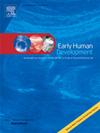Can general movements trajectories predict neurodevelopment as early as six months corrected age in very preterm infants?
IF 2.2
3区 医学
Q2 OBSTETRICS & GYNECOLOGY
引用次数: 0
Abstract
Objective
To evaluate whether prenatal and postnatal clinical variables, General Movements (GMs), and Hammersmith Neurological Examination (HNE) would predict developmental delay. at 6 months corrected age (CA) in preterm infants.
Methods
Infants born <32 weeks gestational age or <1500 g were enrolled in the first days of life and underwent neurodevelopmental follow-up until 6 months CA. Potential associations between motor, cognitive, and language development assessed by the Bayley Scales of Infant and Toddler Development, Third Edition (BSID-III) at 6 months CA, and clinical variables, GMs at term equivalent age (TEA) and Fidgety period, HNE at TEA and 3 months CA, were investigated by Mann Whitney U test, chi-square test, Spearman correlation test, multiple logistic regression.
Results
Ninety-eight infants were included. GMs anomalies at TEA predicted an increased risk of motor delay at 6 months CA, regardless of Fidgety quality at 3 months GA (GMs anomalies at TEA and pathological Fidgety, OR 16.05 [95 % CI 1.02–253.50]; GMs anomalies at TEA and normal Fidgety, OR 11.16 [95 % CI 1.18–105.31]). Despite several variables, including GMs, were associated to cognitive and language delay at 6 months CA (p < 0.05), none was found predictive at the multivariate analysis.
Conclusions
GMs at specific timepoints and GMs trajectories are predictive of early motor delay assessed as early as 6 months CA. Further research is needed to develop standardised protocols for neurodevelopmental longitudinal assessment and to investigate GMs trajectories and their integration with other predictors of neurodevelopment.
一般的运动轨迹能预测早在6个月矫正年龄的早产儿的神经发育吗?
目的评价产前和产后临床指标、全身运动(GMs)和哈默史密斯神经学检查(HNE)对发育迟缓的预测作用。6个月矫正年龄(CA)的早产儿。方法:32周或1500克出生的婴儿在出生后第一天入组,并接受神经发育随访,直到出生后6个月。在出生后6个月,通过Bayley婴幼儿发育量表第三版(bsidi - iii)评估的运动、认知和语言发育与临床变量,足月等效年龄(TEA)的GMs和烦躁期(TEA和3个月的HNE)之间的潜在关联,通过Mann Whitney U检验进行调查。卡方检验、Spearman相关检验、多元逻辑回归。结果纳入98例婴儿。TEA时的GMs异常预测6个月CA时运动延迟的风险增加,而不考虑GA 3个月时的烦躁质量(TEA时的GMs异常和病理性烦躁,OR 16.05 [95% CI 1.02-253.50];TEA和正常躁动的GMs异常,OR 11.16 [95% CI 1.18-105.31])。尽管包括GMs在内的几个变量与CA 6个月时的认知和语言延迟有关(p <;0.05),在多变量分析中没有发现预测性。结论特定时间点的GMs和GMs轨迹可以预测早在CA 6个月时评估的早期运动延迟。需要进一步研究制定神经发育纵向评估的标准化方案,并研究GMs轨迹及其与其他神经发育预测因子的整合。
本文章由计算机程序翻译,如有差异,请以英文原文为准。
求助全文
约1分钟内获得全文
求助全文
来源期刊

Early human development
医学-妇产科学
CiteScore
4.40
自引率
4.00%
发文量
100
审稿时长
46 days
期刊介绍:
Established as an authoritative, highly cited voice on early human development, Early Human Development provides a unique opportunity for researchers and clinicians to bridge the communication gap between disciplines. Creating a forum for the productive exchange of ideas concerning early human growth and development, the journal publishes original research and clinical papers with particular emphasis on the continuum between fetal life and the perinatal period; aspects of postnatal growth influenced by early events; and the safeguarding of the quality of human survival.
The first comprehensive and interdisciplinary journal in this area of growing importance, Early Human Development offers pertinent contributions to the following subject areas:
Fetology; perinatology; pediatrics; growth and development; obstetrics; reproduction and fertility; epidemiology; behavioural sciences; nutrition and metabolism; teratology; neurology; brain biology; developmental psychology and screening.
 求助内容:
求助内容: 应助结果提醒方式:
应助结果提醒方式:


